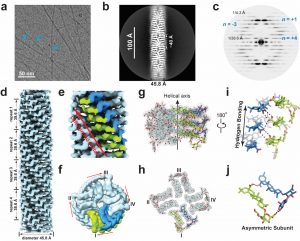A research team led by Song He, assistant professor in the Institute of Chinese Medical Sciences (ICMS) at the University of Macau (UM), has revealed the high-resolution cryogenic electron microscopy (cryo-EM) structure of a supramolecular nanofibril assembled from a natural compound found in traditional Chinese medicine (TCM). The study revealed not only the structure’s unique antifungal activity, which is absent in its single-molecule state, but also its precision in disrupting Candida albicans (C. albicans), the pathogen responsible for vulvovaginal candidiasis (VVC). This offers a novel therapeutic strategy. The research has been published in the international journal Advanced Materials.
Supramolecular structures are ubiquitous in nature. Since Winston and Crick discovered the double helix structure of DNA using X-ray diffraction in the 1950s, scientists have found that peptides and proteins (e.g. Aβ fibrils) can self-assemble into helical supramolecular structures that play a key role in diseases such as Alzheimer’s disease. However, TCM and natural product research has long lacked of high-resolution evidence of whether small-molecule active ingredients form functional supramolecular assemblies, and their self-assembly mechanisms. Conventional techniques such as atomic force microscopy (AFM), scanning electron microscopy (SEM), and low-resolution transmission electron microscopy (TEM) lack the spatial resolution required to visualise atomic structures. Previous cryo-EM studies, which rely on molecular dynamics simulation, have also had difficulties in resolving the helical structure.
To overcome these limitations, Prof Song’s research team conducted research on Zingibroside R1 (ZR1), a saponin derived from Panax notoginseng. They discovered that, without exogenous additives, the TCM compound undergoes spontaneous self-assemble into a hydrogel through heating-cooling method. Using high-resolution cryo-EM, the team reconstructed a 3D map of the ZR1 nanofibrils at 2.5 Å resolution, revealing a left-handed, four-stranded helical structure. The high-resolution data revealed the precise hydrophobic and hydrophilic interactions, as well as role of the supramolecular structure in antifungal activity: The ZR1 hydrogel disrupts the cell membrane integrity in C. albicans, leading to the leakage of intracellular contents.
This research was a collaborative project conducted by Prof Song’s research team and a research team led by Shi Junfeng, professor in the School of Biomedical Sciences at Hunan University. Prof Song’s team was responsible for structural analysis, and Prof Shi’s team was responsible for functional verification. Peng Mengyun, a PhD student at Hunan University, and Peng Qiwei, a Master student at UM, are the co-first authors of this study. The research was funded by UM (File No: MYRG-GRG2024-00283-ICMS-UMDF and SRG2023-00054-ICMS), and the Science and Technology Development Fund of the Macao SAR (File No: 0068/2023/ITP2, 0007/2022/AKP, and 005/2023/SKL). The full text of the research article is available at: https://advanced.onlinelibrary.wiley.com/doi/full/10.1002/adma.202503283.
| Source: Institute of Chinese Medical Sciences | |
| Media Contact Information: | |
| Communications Office, University of Macau | |
| Albee Lei | Tel: (853) 8822 8004 |
| Bell Leong | Tel: (853) 8822 8009 |
| Email: | prs.media@um.edu.mo |

